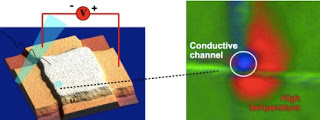Synchrotron x-rays probed the memristor in a 100 nanometer region with concentrated oxygen vacancies (right, shown in blue) where the memristive switching occurs. Surrounding this region a newly developed structural phase (red) was also found to act like a thermometer revealing how hot the device becomes when read or written.
* In testing, they have switched these devices over 30 billion times and counting, with no degradaton in their ability to retain information
Not only does an applied voltage drive the migration of oxygen vacancies in the device, but at the same time there is a current that heats it up to about 300 degrees Celsius—just enough to turn the amorphous film into a crystalline film
Register UK – HP has figured out the physical and chemical mechanisms that make memristors work.
The core advantage of memristors is that they can theoretically achieve speeds 10 times that of flash at one-tenth the power budget per cell. They can also be stacked, enabling exceptionally dense memory structures.
HP Labs has working devices with three-nanometer memristors that switch on and off in about a nanosecond and could store 20GB in a square centimeter.
HP joined forces with the Korean memory manufacturer Hynix to fabricate ReRAM (resistive random access memory) modules, with a planned ship date of 2013
If you liked this article, please give it a quick review on ycombinator or StumbleUpon. Thanks

Brian Wang is a Futurist Thought Leader and a popular Science blogger with 1 million readers per month. His blog Nextbigfuture.com is ranked #1 Science News Blog. It covers many disruptive technology and trends including Space, Robotics, Artificial Intelligence, Medicine, Anti-aging Biotechnology, and Nanotechnology.
Known for identifying cutting edge technologies, he is currently a Co-Founder of a startup and fundraiser for high potential early-stage companies. He is the Head of Research for Allocations for deep technology investments and an Angel Investor at Space Angels.
A frequent speaker at corporations, he has been a TEDx speaker, a Singularity University speaker and guest at numerous interviews for radio and podcasts. He is open to public speaking and advising engagements.


